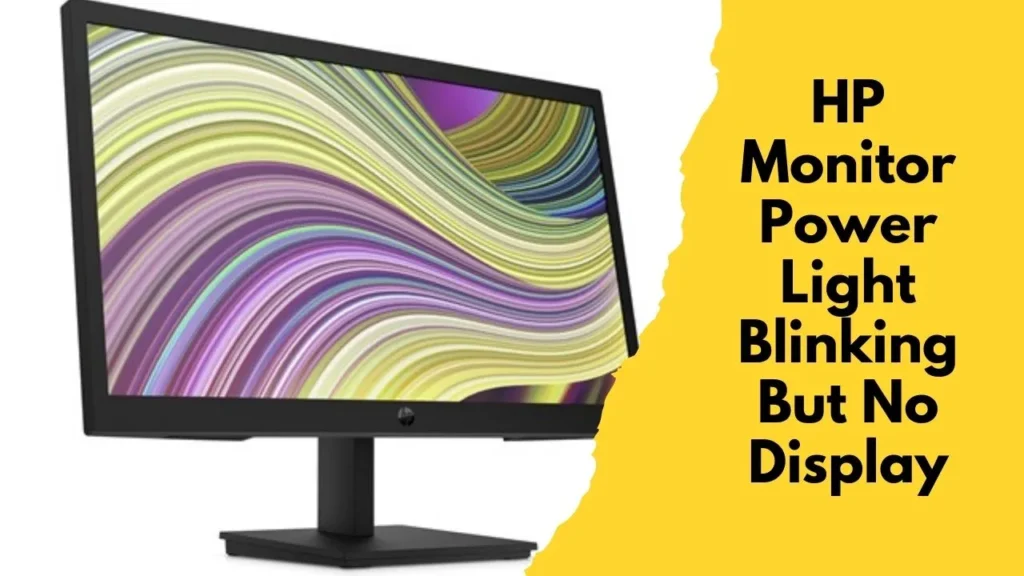Table of Contents
While using the computer screen unexpectedly turns black. Despite my attempts to power off and restart the monitor, it remained unresponsive.
The persistent blinking of the power light confirmed the receipt of electricity, but there was no accompanying image, leading to growing frustration.
To identify the root cause of the black screen issue, I delved into common problems associated with monitors. In this article, I will share my experience, exploring potential factors behind the problem and offering solutions to rectify it.

How To Fix Monitor Power Light Blinking But No Display
If your monitor’s power light is blinking without displaying anything, the issue may stem from glitches, a malfunctioning power cord or HDMI cable, port obstructions by dust, loose cable connections, resolution discrepancies, or a corrupted graphics card.
To address this, troubleshooting steps involve power cycling the monitor, replacing the power and HDMI cables, cleaning the ports, re-establishing cable connections, adjusting the resolution, and if necessary, replacing the graphics card.
Why is my computer’s power button blinking and not turning on
Before we dive into troubleshooting, let’s clear up some confusion about a “blinking monitor light.” This term can refer to different lights in your computer setup.
Most monitors have a power indicator light, and if it’s blinking, it can convey important information. Manufacturers often use blink codes associated with this light to help identify problems.
But there’s more to consider—besides the power indicator light, the entire backlight system of the monitor might also blink or flash, presenting a separate issue. Additionally, monitors can have other lights, and any of them might blink too.
To keep things simple, let’s focus on the power indicator light and flashing backlight for now. If other lights are blinking, it’s best to check your monitor’s model and brand for specific details.
Now, let’s get into the general troubleshooting steps:-
Power Related Issues – Perform Monitor Power Cycle
Power cycling your monitor is a simple yet effective process designed to address potential power-related issues or settings hindering proper display functionality.
Follow these steps to fix HP monitor Power Light Blinking:-
- Turn off the monitor completely.
- Plug out the power cord from the power connector.
- Wait for 20 to 30 seconds before plugging it back to the power connector.
- If your monitor is connected to a power strip, turn off the strip and wait 30 seconds before powering it back on.
- After completing the power cycle, turn your monitor on and check if the display functions correctly.
If the issue persists, consider trying an alternate cable or port, especially if your monitor’s screen remains black with a blinking power light.
See also: Optimizing Monitor Screen Brightness For Healthy Eyes Best Guide 2024
Examine all cables carefully, as even a slight looseness can be the culprit.
The blinking power light consumes less electricity than the entire display, raising the possibility of an inadequate power supply.
It’s also plausible that internal circuitry may be damaged, resulting in power reaching the light but not the rest of the monitor.
Conduct a straightforward test by using reliable cables. You can also interchange power supplies, power strips, and outlets involved to ensure both the monitor and the connected computer receive a stable source of electricity.
The most common reason for a blank monitor with a blinking light is a lack of video feed. Confirm that the computer is powered on, connected correctly to the monitor, and receiving power.
If the issue persists, focus on cable checks as the initial troubleshooting step, addressing power issues before delving into more complex resolutions.
Replacing a Faulty Power Cord:
If the power light on your monitor continues to blink with no display, a faulty power cable could be the culprit.
Check Power Outlet Functionality:
Ensure the power outlet is working by testing it with a functional device like a lamp or radio.
If the outlet proves non-functional, the issue may be with the power cord.
Verify Power Cord Compatibility of HP Monitor:
When replacing the faulty power cord, choose one that matches the voltage requirements of your monitor.
This information is usually found on the monitor or in its user manual.
Select an Appropriate Replacement Cord to Fix the Power Light Blinking:
Look for a replacement cord that meets the specifications of your monitor.
Disconnect and Replace:
Once you’ve acquired a suitable replacement cord, the process of disconnecting the old one and connecting the new one should be straightforward. Ensure the monitor is powered off before making the switch.
By following these steps, you can address power issues associated with a blinking light and potentially restore your monitor’s display functionality.
Connection Issues
Replacing a Faulty HDMI Cable:
If your monitor is blinking and displaying no content, a faulty HDMI cable might be the culprit.
Note: Replacing it is a straightforward process
Verify Cable Functionality:
Confirm that the cable is indeed faulty and not a result of a monitor issue.
Prepare for Replacement:
Shut off the computer or device connected to the monitor and unplug all associated cables.
Access HDMI Input Port:
If determined that the cable needs replacing, locate the HDMI input port on the back of the monitor. Unscrew any screws holding down the port.
Replace the HDMI Cable:
Gently pull out the old HDMI cable and insert a new one in its place.
Reassemble and Reconnect:
Reattach any screws that were removed and reconnect all cables to their respective ports.
Power On:
Power on both the monitor and the connected device.
By replacing the HDMI cable, you should restore full functionality to your monitor.
Reseat Video Connection:
Ensure the video connection between the monitor and the computer is secure. A loose connection could be the source of the problem.
Test with Known-Good Cables:
If the issue persists, try testing with known-good cables and connectors. If access to spare cables is limited, consider seeking assistance from local tech support providers.
Port and Hardware:
Addressing Dust Inside Monitor Ports:
If your monitor’s power light blinks without displaying anything, the cause might be dusty ports. Dust accumulation can lead to various issues and adversely affect your monitor’s health.
Airflow Disruption:
Dust accumulation hinders airflow, disrupting the normal functioning of the monitor.
Electrical Issues:
Electrically charged dust particles can cause arcing or shorting when they come into contact with components on the circuit board, potentially leading to damaging electrical shocks and component destruction.
Ventilation and Cooling Obstruction:
Dust can block ventilation ports and obstruct cooling fans, causing overheating and malfunctioning. Overheating may lead to pixel burnout, resulting in permanent screen damage.
Preventive Measures:
To safeguard your monitor from dust-related damage, consider the following steps
Regular Cleaning:
Clean ports regularly using compressed air or a vacuum with a soft brush attachment. This helps maintain proper airflow and prevents dust buildup.
Checking and Reconnecting Connection Adapters:
If your monitor’s power light blinks without displaying anything, it may signal a loose connection between the monitor and another device, such as the power, video, or audio cable.
Inspect Cable Connections:
Ensure that all cables, including power, video, and audio cables, are securely attached. Loose connections could be the cause of the blinking power light.
Check for Wear and Tear:
Examine cables for any signs of damage. Damaged cables may exhibit similar symptoms, leading to a loss of display. Replace any cables showing signs of damage.
Verify Power Source:
Confirm that the power source for the connected device is functioning correctly. Faulty power sources can contribute to display issues.
Reconnect Cables:
For added stability in the connection, unplug all cables from both the monitor and the connected device before reconnecting them. This helps ensure a secure and stable connection.
Monitor Hardware Diagnosis:
Diagnosing hardware problems with a monitor is not a common route for home users due to its complexity.
Tutorials may guide you through the process, but typically, dismantling the monitor is necessary to pinpoint the exact location of a hardware issue.
Alternatively, seeking professional assistance from a technician or a repair shop is a recommended course of action.
If none of the previously mentioned steps resolve the issue, a hardware problem is probably affecting the monitor.
While it’s conceivable that the problem is fixable, the cost-effectiveness of repairing versus replacing the monitor should be considered.
In many cases, opting for a replacement proves to be more economical than attempting repairs.
Display Settings
Disabling Power Saving Mode:
To resolve the issue of a blinking power light with no display on the monitor, disabling the power saving mode is a simple and effective solution.
Access Monitor Settings:
Locate the settings menu on your monitor. Depending on the model, you may find it under the “Display” or “Power Management” tab.
Locate Power Saving Mode Setting:
Within the settings, look for a box titled “Enable Power Saving Mode.” This option may vary in name depending on your monitor’s make and model.
Uncheck the Option:
Uncheck the box to deactivate the power-saving mode. This ensures that the monitor remains active and operational, even in the presence of potential disruptions in the power supply.
Alternative Names and Settings:
Note that the power-saving mode setting might have different names based on your monitor’s make and model.
Some monitors may require users to manually set them to never enter sleep or standby mode.
Adjusting Screen Resolution to Resolve Display Issues:
If your monitor’s power light blinks without displaying anything, it might indicate a resolution-related problem.
Access Display Settings:
Open the “Display Settings” menu from your computer’s Control Panel.
Select New Resolution:
Within the Display Settings window, choose a new resolution from the provided list of options.
Confirm and Save:
After selecting a new resolution, your computer may prompt you to confirm the selection.
Save the changes to apply the new resolution.
This action can resolve flickering or other display issues.
Consider Safe Mode:
In some cases, starting the computer in Safe Mode can help correct resolution-related problems.
Safe Mode reduces graphics requirements and may provide a temporary solution.
Graphics Drivers
Addressing Corrupted Graphics Drivers:
When a monitor’s power light blinks without displaying anything, the issue may stem from corrupted graphics drivers.
Graphics drivers act as the communication bridge between the operating system and the computer’s hardware.
To resolve this problem, follow these steps:-
Recognize the Issue:
Understand that corrupted graphics drivers can hinder the monitor from displaying content.
Repair or Reinstall Drivers:
Repairing or reinstalling graphics drivers is essential. Utilize a driver updater tool that scans your system for outdated or faulty drivers.
The tool replaces them with updated versions compatible with your hardware.
Manual Reinstallation:
Alternatively, manually uninstall and reinstall the drivers. This can be done by searching for the drivers online or visiting the manufacturer’s website.
By addressing corrupted graphics drivers through either automated tools or manual intervention, you can potentially resolve the blinking power light issue and restore normal display functionality to your monitor.
FAQs – Monitor Issues
Why Is My Monitor’s Power Button Flashing?
A flashing power button on your monitor could indicate various issues, including power supply problems, connection issues, or internal hardware malfunctions.
What to Do If the Monitor Is on but No Display?
If your monitor is powered on but not displaying anything, try checking cable connections, adjusting screen resolution, verifying power-saving settings, or troubleshooting graphics drivers.
These steps may help identify and resolve the issue.
Why Is My Monitor on but the Screen Is Black?
A black screen despite the monitor being on may be due to loose cables, incorrect display settings, power-saving mode, or faulty graphics drivers.
Why is my monitor light blinking and not turning on?
A blinking monitor light without turning on may be attributed to power-related issues, faulty cables, or hardware problems.
Power cycle the monitor, replace faulty cables and check hardware connections to troubleshoot.
Why is the power button on my monitor flashing?
A flashing power button could signify power supply issues, connection problems, or hardware malfunctions.
Investigate power sources, and cable connections, and perform relevant troubleshooting steps to determine the cause.
Why is my monitor light on but no display?
If the monitor light is on, but there’s no display, it may be due to issues like faulty cables, power saving settings, resolution problems, or corrupted graphics drivers.
Addressing these factors can help resolve the no-display issue.





